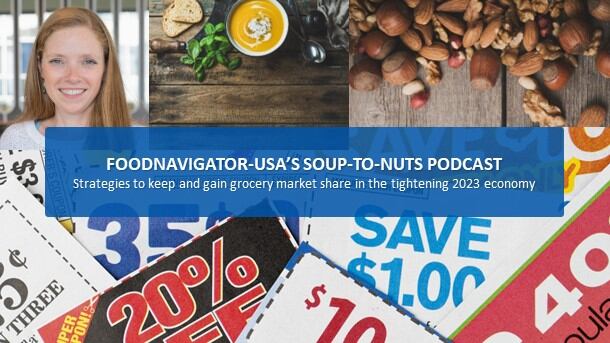Yes, many shoppers will continue to avoid certain ingredients and foods, but according to Matt Schueller, director of insights and analytics at Ardent Mills, an emerging school of thought among consumers is instead of “eating to be healthy” (which includes avoiding sugar, limiting carbs and slashing sodium) they are “eating for health” (which includes seeking fortified products and options with health beneits). He explains this is a subtle but important shift that rewards manufacturers that offer more of the good aspects consumers want – whether it be nutrients or alignment with certain principles that they have.
In this episode of FoodNavigator-USA’s Soup-to-Nuts podcast, Schueller explores how consumers are redefining a healthy diet – including how they think about competing priorities ranging from functional nutrition and taste to sustainability and convenience. He also shares emerging ingredients and strategies that can help manufacturers meet these evolving needs without compromise.
[Editor’s note: Never miss an episode FoodNavigator-USA’s Soup-to-Nuts podcast – subscribe today.]
Emerging from the ‘crucible’ of 2020
According to Schueller, many of the emerging trends that will shape how consumers eat in 2023 are grounded in the pandemic, which for better or worse forced many Americans to take a closer look at their health and by extension their diets.
“2020 was sort of the crucible that a [forged] lot of the trends that are in place today, but more importantly, are accelerating and will play out in 2023,” including a sense of empowerment and the idea that they can leverage food and beverage to influence their heath and wellness, he explained.
He pointed to research by Ardent Mills that reveals as consumers become more comfortable with the idea of food as medicine more of them are seeking out functional foods and doing so more often. For example, more than three-quarters of consumers reported to Ardent Mills that they are adopting a functional foods mindset at least occasionally and 35% said they will do so more often in the coming year.
Schueller adds consumers also are seeking out functional foods for a wider variety of reasons than early in the pandemic when they primarily focused on immunity.
“We’ve been able to pull back the layers a little bit … and understand how the consumer defines immune health,” including an increased understanding of and interested in prebiotics, probiotics and postbiotics, which has led to a surge of interest in fiber, he said.
He explained that most consumers think about fiber in terms of digestive health but they also are gaining a deeper understanding of is other health benefits and are looking to increase their intake. But, of course, they don’t want to compromise taste.
An increasingly popular ingredient that can meet and balance these demands is chickpea, which Schueller said offers versatility as well as a long list of in-demand nutrients. For example, he explained, chickpea flour’s beige color and smooth texture make it ideal for blending and baking and its high protein content make it appealing for plant-based options.
Another popular option is quinoa, which Schueller said “remains one of the specialty grains or alternative grains that is best well-known among consumers” and can be used as an ingredient in a blended product or as a standalone offering.
Taste is tablestakes
While health benefits are top of mind for consumers seeking out functional foods, Schueller emphasizes that tasting good “remains table stakes,” which is why Ardent Mills is focused on offering ingredients – like its Sustagrain Barley Flour and its chickpea flour, which he said are healthier without compromising flavor or overcomplicating formulation.
He explained that Sustagrain has more than three times the fiber of oats and corn flour and at least 10 times that of brown rice and can be included in many applications ranging from baked goods to chips to extruded snacks and more without compromising taste.
Ardent Mills also has found ways to reduce the ‘beany’ taste of chickpeas that boosts the performance while maintaining the nutrient profile.
Well & good: balancing taste and function
Closely related to the rising demand for functional food but with a little more wiggle room for taste and personal preference is a growing consumer interest in ingredients and products that make them feel "well and good," which Schueller says places a little more emphasis on taste and perception versus scientific support.
He explained that for those following the well & good mindset “the rigor is lower … when consumers are making choices” because they are approaching dietary selections from a lifestyle perspective rather than an underlying health condition.
As an example, Schueller points to the ongoing boom in gluten-free, which most people choose not because they are allergic to gluten but because they perceive it has healthier. And because they don’t have to choose gluten-free they are less willing to compromise on flavor, texture and experience.
Another example is increased interested a plant-forward diet, which is less stringent than a plant-based diet, Schueller said. Within this trend, he said, consumers are looking for plant-based protein that also tastes good, such as quinoa and chickpea.
A less well-known grain that also fits the bill, and which Schueller says he will be watching closely in 2023, is millet.
He explained that the UN declared 2023 the year of millet and while manufacturers are increasingly using the ingredient “the connection with the consumer is a little bit more of a dotted line” that will require increased education to fill in and further drive demand.
He is optimistic that millet could follow the path of quinoa, which UN declared the star or 2013 and which prompted a flurry of innovation in which new products featuring quinoa more than doubled in the 18 months following the UN’s proclamation.
Modern craft: pushing boundaries while staying grounded
After three years of cooking and eating primarily at home due to the pandemic, most consumers not only are now comfortable with kitchen basics, but many also are bored with them – opening the door for a trend that Arden Mills calls “modern craft,” which Schueller says simultaneously pushes boundaries and remains grounded in comfort.
“Modern craft is the idea that there is an evolving appreciation for things that taste great and are authentic, so it doesn’t need to be sophisticated or elegant,” it just needs to deliver and authentic experience, he explained.
“A great example might be pasta made with pulses, where I’m able to try something new, perhaps get a benefit from it, and it still has got sort of an authentic grounding” and is familiar to consumers, he said.
This mindset also is closely linked to organic. According to Ardent Mills’ research, of the consumers who participate in the modern craft mindset 85% are more likely to eat organic. In addition, 52% said they are more likely to eat organic in the coming year.
Sustainable solutions
Consumer interest in organic also is feeding into the fourth major trend that Ardent Mills is tracking in 2023, which is an increasing desire for sustainable solutions that not only nourishes consumers but also support the creation of a better food system.
Schueller explains that the nearly 60% of consumers are adopting a sustainable solutions mindset at least occasionally and the 22% who claim they will adopt this mindset more frequently in the coming year are looking for a combination of "well being and well doing."
“This trend is still at an evolving stage both by the way we measure it within the industry as well as the way consumers interact with it, but it’s of crucial importance … and it has a lot of opportunity ahead of it,” he said.
He explained the way Ardent Mills currently thinks about this trend is around three pillars: the product at the shelf, the process used to develop the product and the its social positioning related to people.
“About one in 10 consumers indicated that they consistently make food choices with [sustainability] in mind, but also our work suggests that is set for perhaps triple digit growth from a participation standpoint in 2023 and beyond,” he added.
A sizeable roadblock that could slow adoption of this trend is inflation because more sustainable products tend to cost more to produce and therefore have a higher price. Schueller acknowledges that if the US economy continues to tighten and consumers begin to pull back on spending this trend could become more muted among older shoppers. But, he said, younger shoppers appear more willing to make sacrifices elsewhere.
Convenience & optimized solutions
The last trend that Ardent Mills is tracking in 2023 is deeply rooted in the reality of daily living and serves as a counter-weight to some of the other rising value-based trends and it is an increased focused on convenience and optimized solutions.
As Schueller explains many consumers are still establishing new routines after the pandemic upended the norm – elevating the importance of reliable everyday solutions are efficient and consistently deliver successful outcomes.
One way this trend is playing out in foodservice and at home is through an increased demand for blends and mixes that can be used to make multiple products more quickly without sacrificing taste or nutrition.
Consumers are demanding ‘better’
While each of these five trends may contradict each other at times, Schueller says he sees significant synergies within the common themes of wanting ingredients and finished products that are better – be it better for their health, better tasting, better for the planet and better for the their budgets and time constraints.
And, he added, Ardent Mills is ready and willing to help industry stakeholders meet these challenges as opportunities.




